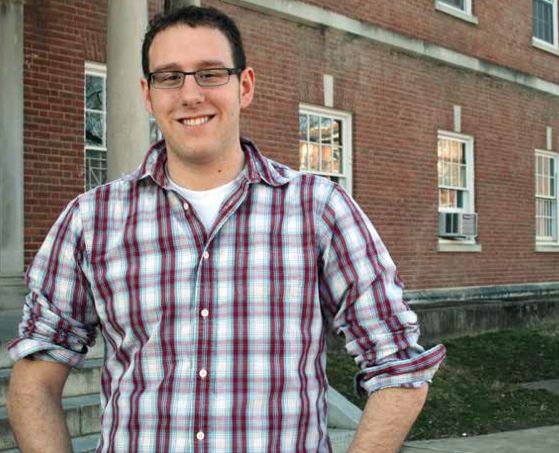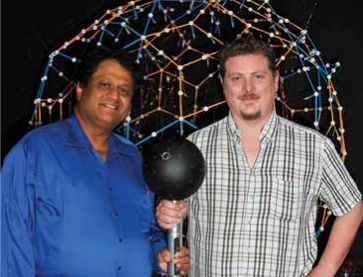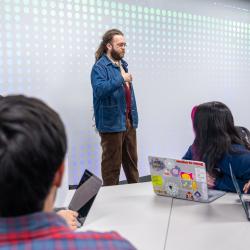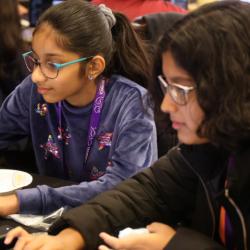Students Catch Innovation Bug Early
Tired of missing the Shuttle-UM by just moments and anticipating a long wait for the next bus across campus, Eric Rosenberg, B.S. ’13, Computer Science, decided to take matters into his own hands. With a team of fellow students, he developed a mobile application that taps into GPS technology to pinpoint the arrival time of the next shuttle. The university’s transportation department was so impressed with the Route Rider app that it recently purchased the rights to post a QR code at each Shuttle UM stop to retrieve the up-to- the-minute arrival predictions.
The Maryland campus is the perfect breeding ground for student start-ups like Rosenberg’s, offering a collaborative atmosphere, faculty experts and additional business resources. “Both the university and CMNS consistently supported our innovation,” says Rosenberg. “Several computer science faculty members gave endless feedback, and the Maryland Technology Enterprise Institute (Mtech) and the Dingman Center for Entrepreneurship provided mentorship.”
Putting Start-ups on the Syllabus
A new upper-level elective, Computer Science Start-ups, promises to add to the mix, giving students an edge in building companies based on computer applications. “The course not only covers general entrepreneurial skills but also those specific to computer science start-ups, touching on everything from marketing on a shoestring budget to interface design,” says Computer Science Professor and former Chair Larry Davis. “We want students to learn to transform an idea for a computer application into a product.”
Davis team teaches the course with three computer science faculty members who have founded start-ups—Professor Ben Bederson, Associate Professor William Arbaugh, and Associate Professor Ramani Duraiswami—as well as Dean Chang, director of Mtech’s venture- creation programs. Guest speakers include alumni entrepreneurs and an intellectual-property expert.
“I’m looking forward to sharing some of my ‘war stories,’” says Bederson, who co-founded the mobile media company Zumobi. “I’ve been involved in everything from investment pitches, to hiring, to setting up offices and running a complex engineering team. These are all areas that entrepreneurs need to think about, but they aren’t typically covered in a computer science course.”
1 Student + 1 Professor = 3-D Audio Camera
Imagine watching a movie where the sound is so immersive you feel you are experiencing each situation shown on screen—whether it is a helicopter hovering overhead, creaking floorboards beneath, or an approaching swarm of buzzing bees. VisiSonics, a venture launched by Duraiswami, who co-teaches the Computer Science Start-ups course, and graduate student Adam O’Donovan (B.S. ’05, Computer Science; B.S. ’06, Physics; Ph.D. candidate, Computer Science) offers the technology to make this feat possible.
Spawned from research conducted at the university’s Perceptual Interfaces and Reality Lab, the VisiSonics audio camera uses 64 microphones and five video cameras to create a 3-D soundscape. End- users wear headphones that allow them to be enveloped by sound.
When O’Donovan joined the lab in 2006 under an NSF-funded project, he never expected to spin off a company with a faculty member. “After we made some hardware advancements and demonstrated our work at conferences, it became clear there was market demand,” he says. “We decided to take our development to the next level and polish it into a commercial device.”
NSF’s Innovation Corps, or I-Corps program, recently awarded the researchers a $50,000 grant to help bring their product to market and is also providing training and mentorship.
The state and university have also been instrumental in getting the business off the ground. A $15,000 grant from the Maryland Technology Development Corporation (TEDCO) helped launch VisiSonics in 2009, and a TEDCO loan helped with commercialization efforts. The company is housed on-campus at Mtech’s business incubator, which offers business guidance.
The cutting-edge audio camera and associated software have several applications in addition to 3-D sound capture. The technology also visually indicates sound reflections with color bursts, and could be used to help architects design concert halls or automobile manufacturers develop a quieter ride. Another feature allows users to isolate conversations from a noisy setting for security and surveillance purposes. (See www.visisonics.com for product demonstrations.)
Still, O’Donovan’s dream is that the entertainment industry will embrace the technology, using it for feature films, video games and concert simulcasts. The Maryland-based producers of the Blair Witch Project have already tested it on an eight-minute film project demo. Says O’Donovan, “It’s incredibly rewarding to see our idea transform into a usable product that could affect so many industries.”









